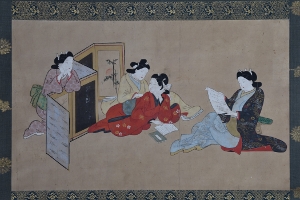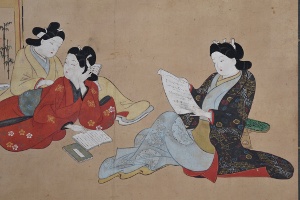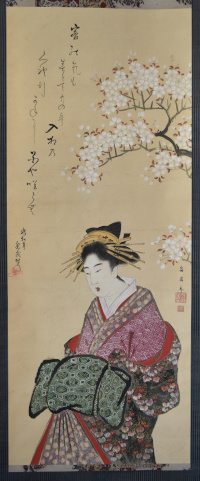Utagawa KUNIYOSHI (1797-1861)
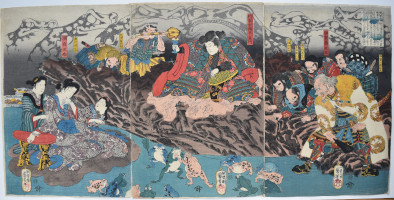
Click here to view image full size.
A triptych showing Shoguntaro Taira Yoshikado (centre), his sister Takiyasha-hime (left), and Yoshikado’s retainer, Iga Jutaro, watching magic toads wrestling. Huge toads loom above them. Shogun Taro Yoshikado mikata wo atsumen ga tame etc. Takiyasha-hime was known for her toad magic which she had gained from a scroll containing their secrets given to her by her brother. Published by Tsuru-ya Kiyemon, 1842-3. Robinson T.89.
Fine impression, colour and condition. Signed Ichiyusai and Chooro Kuniyoshi ga.
Status: Available
Utagawa YOSHITSUYA (1822-1866)
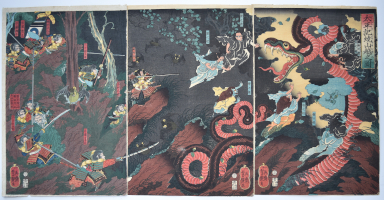
Click here to view image full size.
A triptych with title Taiheike Yakiyama-Goye no zue, “Picture of the Slope of Burning Mountain in the Taiheiki.” Shows the Japanese Daimyo Sato Masakiyo (Kato Kiyomasa), who was a leading general in Toyotomi Hideyoshi’s invasion of Korea, far left, and his men encountering a monstrous serpent surrounded by bats, tengu and flying goblins on a haunted mountain. Published by Kagaya Kichibei, 1861.
Fine impression, colour and condition. A lovely copy of this triptych. Signed Ichieisai Yoshitsuya ga.
Status: Available
Katsukawa SHUN’EI (1762-1819)
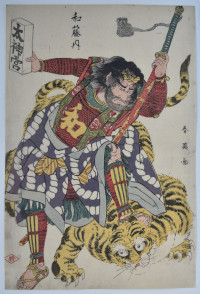
Click here to view image full size.
Shows the half-Chinese, half-Japanese hero Watonai overcomes a man-eating tiger in China by using a charm from the Ise Shrine. He holds a post with the characters reading Daijinga, “Grand Shrine” used in the inner and outer shrines at Ise. Published by Wakasaya Yoichi (Jakurindo), c 1810. Rare.
Fine impression and colour. One small backed edge wormhole, otherwise very good condition. Signed Shun’ei ga
Status: Available
Torii KIYONOBU I (1664-1729)

Click here to view image full size.
A large sumi oban showing a couple in flagrante. These prints were normally issued in sets of twelve and would only have had the signature on the first sheet. Published c 1704-1711. Provenance: Ex Kiyoshi Shibui collection.
Very good impression. Slight edge soil and centre fold with small pin holes, but generally good condition considering the age.
Status: Available
Keisai EISEN (1790-1848)
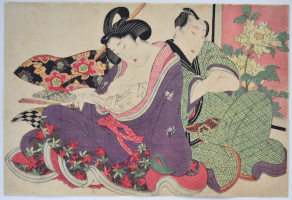
Click here to view image full size.
An amorous couple beside a screen decorated with a large chrysanthemum. From a set of twelve prints Keisei higo, “Secret Words of a Courtesan” published c 1822-25. Although coming under the heading of shunga, each print is an abuna-e design, without any graphic detail. Shows a courtesan with her client. She turns to tie the iwata-sash which indicates she is pregnant.
Fine impression. Very fine colour. Fine condition.
Status: Available
Hosoda EISHI (1756-1829)
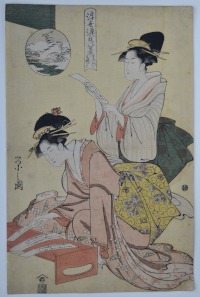
Click here to view image full size.
Two beauties examining tanzaku poetry cards from a set Ukiyo Genji hakkei, “Eight Views of Genji in the Floating World.” The designs stand alone but also form diptychs. This series compares scenes from the famous Tale of Genji novel written by the Lady Murasaki in the early 11th century with the Eight Views of Omi [Lake Biwa]. In the present case, Maboroshi rakugan (viz Katata rakugan, “Descending Geese at Katata”) is compared to chapter 41, Spirit Summoner, of the Tale of Genji where a poem composed by the Akashi Lady is in response to the grieving Genji’s poem after the nocturnal encounter with Murasaki which refers to the wild goose (aka Genji) having flown away. Published by Eijudo c 1797-99. Another impression is in the B.M., reg. no. 1931, 0427,0.8 and an impression is illustrated in Klaus J. Brandt, Hosoda Eishi, 1977, 119, no. 301. Provenance: Sold Sothebys, New York, 28/10/1980, lot 866.
Fine impression. Very good colour with yellow ground. Slight centre fold and very slight trimming, otherwise very good condition. Signed Eishi zu.
Status: Available
Katsushika HOKUSAI (1760-1849)
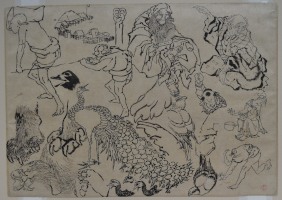
Click here to view image full size.
A sheet of original studies, sumi on thin paper, 10.5 x 15 in; 26.6 x 38 cms. Of particular interest and importance is the self-portrait in the upper right, This is another version of the famous self-portrait at the age of 83 (1842) sent to his publisher. Illustrated in Hokusai Drawings, J. Hiller, Phaidon, 1966, ill. No. 110 from the Rijksmuseum voor Volkenkunde, Leiden, Netherlands. Provenance: Ex Henri Vever collection, seal bottom right.
One small wormhole, otherwise in very good condition.
Status: Available
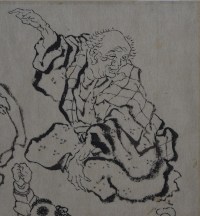
Click here to view image full size.
Tsukioka YOSHITOSHI (1839-1892)
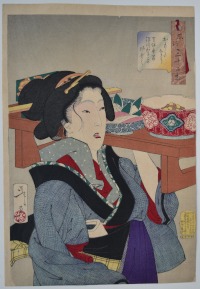
Click here to view image full size.
Omota-so: Tempo nenkan Fukagawa karuko no fuzoku, “Looking Weighed-Down: The Appearance of a Waitress at Fukagawa in the Tempo Era [1830-1844].” Shows the waitress carrying a portable wooden table with food to a geisha party from a set Thirty-two Aspects of Women published by Tsunashima Kamekichi, 1888. The set depicts women of different backgrounds and occupations from the Kansei era through to the Meiji era with punning allusions to their situation or mood.
Very fine impression of the true first edition. Fine colour and condition. Signed Yoshitoshi ga.
Status: Available
Utagawa KUNISADA (1786-1864)
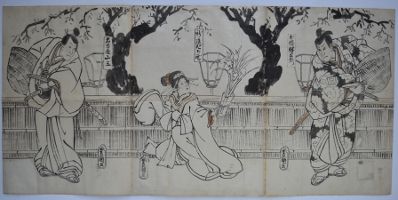
Click here to view image full size.
An original hanshita-e (preparatory drawing) for a triptych showing, from the left, the actor Bando Takesaburo I as Nagoya Sanza, Ichimura Uzaemon XIII as the Shinzo (“courtesan’s apprentice”), and Nakamura Fukusuke I as Fuwa Banzaemon. This is actually from the dance Sanpukutsui Kabuki no irodori performed at the Ichimura-za theatre, 5/1855. The publisher was Sanoki. These first drafts by the artist themselves survive because a more detailed drawing was needed by the blockcutter, and this was normally given to an assistant to execute. Or the drawing was never taken up by the publisher, for whatever reason. Sumi and touches of red with some pentimenti. Signed Toyokuni ga on the three sheets. Sold “as is” with all imperfections.
Status: Available
Utagawa KUNIYOSHI (1797-1861)
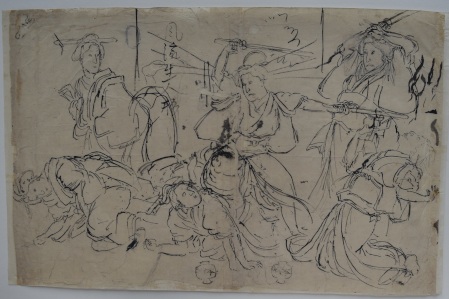
Click here to view image full size.
A fine large original drawing, sumi on thin paper, 12 x 18.5 in; 30.4 x 47 cms. Shows battling women holding what appear to be wooden swords. Two seals at the bottom which appear to be the publisher Honmo who published 1855-56. Provenance: Ex collection Dr. Julius Kurth (1870-1949), an eminent scholar who wrote extensively on Japanese and Chinese art.
Sold “as is” but in good condition.
Status: Available
Shunbaisai HOKUEI (Active 1824-1837)
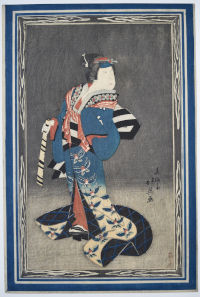
Click here to view image full size.
Shows the actor Arashi Rikan II as the yako Koman holding a shakuhachi and posed within a wooden frame in the play Sugata kurabe deiri no minato, “Comparison of Fighting Figures at the Harbour.” Performed in 1834 at the Naka Theatre, Osaka. A yako was a chivalrous servant, usually of a samurai. Rare: Another impression is in the MIA, acc. no P.75.51.188.
Fine impression with the woodgrain enhanced on the background. Fine colour and condition. Signed Shunbaisai Hokuei ga with the carver’s seal bottom right Kasuke.
Status: Available
Utagawa TOYOMARU (SHUNRO II) (Act. 1785-1797)
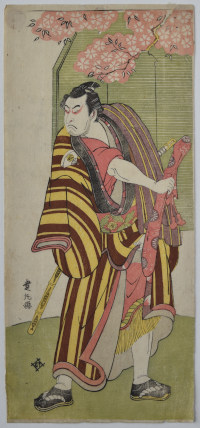
Click here to view image full size.
The actor Onoe Matsusuke, probably in the role of Matsuo-maru in the play Sugawara denju tenarai kagami. Published c 1780s by Igaya Kan’emon (Bunkido).
Fine impression, colour, and condition. Signed Toyomaru ga.
Status: Available
Okumura MASANOBU (1686-1764)

Click here to view image full size.
One of the most influential and innovative print designers, publishers and painters. He is also credited with inventing the hashira-e as well as being the first to use multiple-block printing. A wide hashira-e (habahiro hashira-e, 24 x 6 in; 61 x 15 cms) showing the actor Sanogawa Ichimatsu I. Masanobu designed a number of prints showing this popular actor who started the fashion for the hisobi pattern on his costume which is now called the Ichimatsu moyo. Published by Masanobu c 1741. Rare.
Fine impression. Hand-applied colour: yellow, light red and light orange. Slight fading, otherwise very good condition. Signed Hogetsudo shomei Okumura Bunkaku Masanobu shohitsu, “Truly published by Hogetsudo and true brush by Okumura Masanobu” with seal Tanchosai.
Status: Available
Utagawa HIROSHIGE (1797-1858)
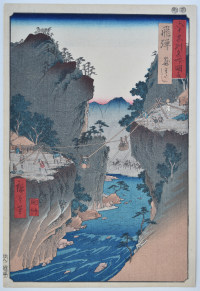
Click here to view image full size.
Hida, kago-watashi, “Basket Ropeway in Hida [Province]” from a set of 69 prints [Dai Nihon] Rokujuyoshi meisho zue, “Famous Places in the Sixty-odd Provinces [of Japan]” published by Koshihei between 1853 and 1856, this being 1853. Originating in China, Japan and northern India, travellers could cross deep ravines by suspending themselves in a harness which evolved into a basket.
Very fine impression and colour. Light album backing, otherwise fine condition. Signed Hiroshige ga.
Status: Available
Utagawa HIROSHIGE II (1826-1869)
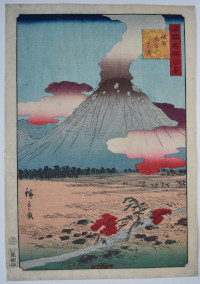
Click here to view image full size.
A view of a smoking Mt Asama, Shinano Province, from Shokoku meisho hyakkei, the “One Hundred Views of Famous Places in the Provinces.” Mt Asama is an active volcano which violently erupted in 1108. Subsequently there was another eruption in 1783 and since then there have been minor tremors. Published by Uoya Eikichi between 1859 and 1861 (this being 1859).
Fine impression, colour and condition. Signed Hiroshige ga.
Status: Available
Utagawa HIROSHIGE (1797-1858)
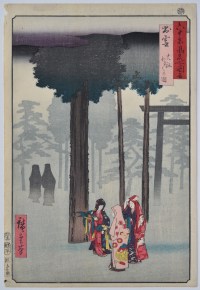
Click here to view image full size.
Izumo, taisha Hotohoto no zu, “Izuma [Province], Hotohoto Festival at Izumo Shrine.” Shows pilgrims to the oldest Shinto shrine in Japan. A heavy mist scene with the torii gate seen to the right. Every year from the 11th to the 17th day of the 10th lunar month (usually November) all Shinto’s deities from around Japan supposedly assembled here. It is also the shrine to visit in the hope of finding a partner. From a set of 69 prints [Dai Nihon] Rokujuyoshi meisho zue, “Famous Places in the Sixty-odd Provinces [of Japan]” published by Koshimuraya Heisuke between 1853 and 1856, this being 1853.
Very fine impression and colour. Light album backing and very small wormhole at extreme edge of margin, top left, otherwise fine condition. Signed Hiroshige ga.
Status: Available
ANONYMOUS (Mid to late 19th century)

Click here to view image full size.
A fine original painting in muted tones on silk, 43.75 x 16.5 in; 111.2 x 41.9 cms. Shows a vengeful female ghost (yurei) emanating from a ball of fire. She wears a plain white kyokatabira (funeral robe), has long unkept hair and her claw-like hand clutches her skeletal chest. Yurei-zu reached a peak of popularity in the 19th century, there being a seemingly insatiable demand from the public for stories of ghosts, demons and the supernatural reflected in popular fiction, Kabuki drama and art in general. These ghost paintings were often not signed: This one bears two seals reading “surpassing lotus” and “happy and heaven.” In very good condition with the surrounding mount: hashira and ichimonji areas painted in imitation of silk (kaki byoso) and the image overlapping these areas.
Status: Available
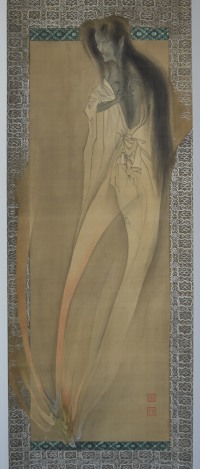
Click here to view image full size.
Hishikawa MOROSHIGE (FL. 1684-1704)
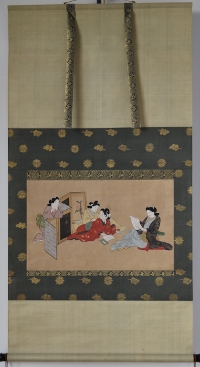
Click here to view image full size.
An original painting showing a high-ranking samurai household at leisure. Moroshige was the senior pupil of Hishikawa Moronobu, and, it is said, was the father of Furuyama Moromasa. Sumi and full colour with gold additions on paper. 11.5 x 19 in; 29 x 48.25 cms. This is most likely from a handscroll as the height is correct, and the slight vertical striations indicate it has been rolled at some time. Painted c. 1700. Some slight loss of pigments, especially the verdigris and minor marks, but all commensurate with the age of the painting. The details on the costumes of the two main figures are exquisite.
Status: Available
KYOJINSAI (Fl. c 1789-1801)
Click here to view image full size.
A large and fine original painting by an artist whom I am unable to find in the literature; possibly a pseudonym. Shows a high-ranking courtesan wearing a sumptuous kimono under cherry blossom. Full colour on paper, 49.25 x 20 in; 125 x 51 cms. The calligraphy above is by Kan’watei Onitake, best known as the author of a series of yomihon entitled Katakiuchi kidan Jiraiya setsuwa , “The Tale of the Gallant Jiraiya,” also known as the Jiraiya monogatari published in 11 volumes from 1806-7. The protagonist was a thief-come-wizard who is usually depicted astride a giant toad. Onitake was a pupil of Tani Buncho, Kyokutei Bakin and Santo Kyoden. It translates as a courtesan musing on the fact that customers’ attention in the spring turns to buying many things and, as the sun sets, will there be many clients in the Yoshiwara gathering as thickly as the cherry blossom. Signed Kan’watei Onitake san with a kakihan of an octopus. On the right the signature and seal of Kyojinsai. On the lid of the box is an inscription reading Kansei-ki Kyojinsai-hitsu oka no tayu sugata gasan, “A Kansai period inscribed painting of a high-class courtesan under cherry blossoms brushed by Kyojinsai.” And a repeat of the Onitake inscription. On the inside of lid: Showa shinyu Yayoi chukan, “Mid-March of the metal rooster [Showa 56/1981].” Appraised by Kimura Suetsuke ((a dealer and Ukiyo-e expert). Very good condition.
Status: Available
Utagawa KUNISADA (1786-1865)
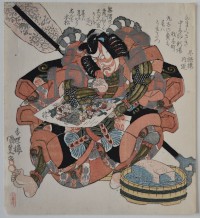
Click here to view image full size.
A surimono showing the actor Ichikawa Danjuro VII in the role of Soga no Goro holding a print of the shichifukujin in the takarabune. A parody of the Yanone no Goro story: Yanone means “arrowhead” and is one of the eighteen famous plays in the Danjuro canon, belonging to the Soga Brothers cycle. He is shown with the over-large arrow and whetstone for sharpening it. Poem by Jingoro Uchichika. The printer’s seal Kozensai bottom left. (The same seal appears on a number of other Danjuro VII surimono.) He also appears in the role of a poet and possibly belonged to the Mimasu-ren poetry club that supported the Danjuros. A very fine surimono.
Very fine impression. Fine colour and condition. Signed Kochoro Kunisada ga with double toshidama seal.
Status: Available
Kitagawa UTAMARO (1753-1806)
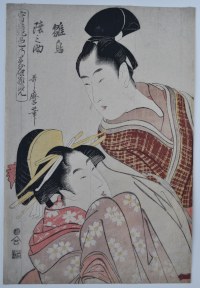
Click here to view image full size.
The lovers Hinadori and Kuganosuke from a series of half-length portraits of pairs of lovers featured in joruri love-suicide plays. (Joruri were bunraku puppet dramas). Jitsu kurabe iro no minakami, “True Feelings Compared: The Founts of Love.” At the height of their popularity the Japanese government cracked down on these joruri plays as they were inspiring copycat double suicides amongst the population. Published by Nishimuraya Yohachi, c 1798-9.
Fine impression. Very good colour. Some paper chain lines visible, otherwise very good condition. Signed Utamaro hitsu.
Status: Available
Attributed to Suzuki HARUSHIGE (Shiba KOKAN 1747-1818)
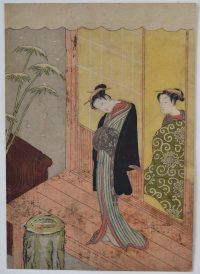
Click here to view image full size.
A winter scene with a young courtesan on an engawa gazing at an upturned ladle resting in a water basin formed from a hollow tree trunk. Behind her a young beauty peers out through the shoji. The scene calls to mind the Bell of Damnation (Muken no kane) act in the play Hiragana Seisuiki where Umegae strikes the water basin with a ladle to produce gold coins. Harushige was the ukiyo-e go of Shiba Kokan, the first artist to try copper plate engraving and who studied oil painting and etching from books he saw in Nagasaki. For a time a pupil of Harunobu whose style his prints resemble. Extremely rare: I cannot, at the moment, locate another impression. Published c early 1770s.
Fine impression. Extremely good colour, the orange pigment partly oxidised. Possibly slightly trimmed left and bottom, otherwise very good condition.
Status: Available
Tsukioka YOSHITOSHI (1839-1892)
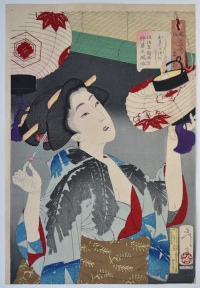
Click here to view image full size.
Okigatsuki-so: Meiji nenken saikyo nakai no fuzoku, “Looking Capable: The Appearance of a Kyoto Waitress in the Meiji Era [1867-1912].” Shows the waitress of a Kyoto geisha house whose job was to act as a go-between for customer and geisha. From a set Thirty-two Aspects of Women published by Tsunashima Kamekichi, 1888. The set depicts women of different backgrounds and occupations from the Kansei era through to the Meiji era with punning allusions to their situation or mood.
Very fine impression of the true first edition. Fine colour and condition. Signed Yoshitoshi ga.
Status: Available
Tsukioka YOSHITOSHI (1839-1892)
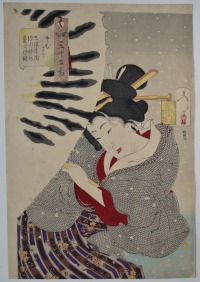
Click here to view image full size.
Samu-so: Tempo nenkan Fukagawa Nakamachi geisha fuzoku, “Looking Frozen: The Appearance of a Fukagawa Nakamachi Geisha in the Tempo Era [1830-1844].” Shows a beauty caught in a snowstorm, her umbrella laden with snow from a set Thirty-two Aspects of Women published by Tsunashima Kamekichi, 1888. The set depicts women of different backgrounds and occupations from the Kansei era through to the Meiji era with punning allusions to their situation or mood.
Very fine impression of the true first edition. Fine colour and condition. Signed Yoshitoshi ga.
Status: Available
Ichiryusai HIROSHIGE (1797-1858)
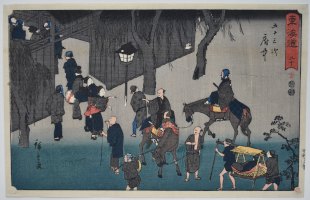
Click here to view image full size.
Fuchu from The Fifty-three Stations of the Tokaido published by Marusei, Maruya Seijiro, 1847-52. Called the Reisho Tokaido because of the angular style of Kanji used. Travellers coming and going at the entrance to the station. One of the best designs from the set. Provenance: Ex Hayashi collection with seal below title cartouche.
Fine impression and colour. Very good condition. Signed Hiroshige ga.
Status: Available
Utagawa HIROSHIGE (1797-1858)
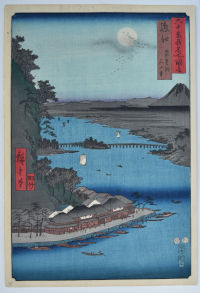
Click here to view image full size.
Omi, Biwako Ishiyamadera, “Ishiyama Temple and Lake Biwa in Omi [Province].”From a set of 69 prints [Dai Nihon] Rokujuyoshi meisho zue, “Famous Places in the Sixty-odd Provinces [of Japan]” published by Koshihei between 1853 and 1856, this being 1853. Moonlight on Lake Biwa is one of the iconic Eight Views of Omi.
Very fine impression and colour. Light album backing, otherwise fine condition. Signed Hiroshige ga.
Status: Available
Utagawa HIROSHIGE (1797-1858)
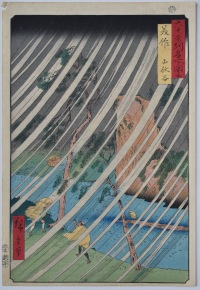
Click here to view image full size.
Mimasaka, Yamabushidani, “Mimasaka [Province], Yamabushi Valley.” Travellers caught in heavy wind and rain in the valley. Hiroshige II also produced an excellent version of this design. From a set of 69 prints [Dai Nihon] Rokujuyoshi meisho zue, “Famous Places in the Sixty-odd Provinces [of Japan]” published by b Koshimuraya Heisuke between 1853 and 1856, this being 1853.
Very fine impression and colour. Light album backing and very small wormhole at extreme edge of margin, top left, otherwise fine condition. Signed Hiroshige ga.
Status: Available
Utagawa KUNIYOSHI (1797-1861)
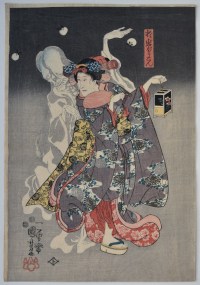
Click here to view image full size.
Oiwa and her ghost: Yondaime Ichikawa Kodanji IV no Oiwa bokon, “The Spirit of Oiwa Performed by Ichikawa Kodanji IV.” Probably in the play Atari mimasu yotsuya no kikigaki, performed at the Kawarasaki Theatre, 1848. The popular story has many versions, the gist being that Oiwa’s husband, Kamiya Lemon, falls in love with Oume, the daughter of a rich neighbour. Oume’s family poison Oiwa so that Lemon can marry the daughter. The poison hideously disfigures Oiwa who comes back to haunt Lemon. Published by Ebiya Rinnosuke, 1848.
Fine impression, colour and condition. Signed Ichiyusai Kuniyoshi ga.
Status: Reserved
Utagawa KUNIYOSHI (1797-1861)
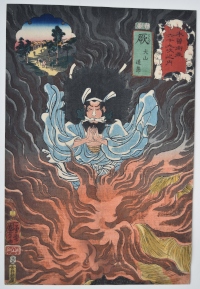
Click here to view image full size.
Inuyama Dosetsu, one of the eight dog heroes, enveloped in a conflagration. The heroes represent a Confucian ideal or Buddhist regulation and meet various adversaries in the epic Nanso satomi hakkenden, “Biography of the Eight Dogs” written by Takizawa Bakin between 1814 and 1842. Dosetsu is gifted with magic fire and is seen here with pine sprigs wrapped in paper clenched between his teeth. The subject represents Warabi Station (seen top left) from a set Kisokaido rokujuku tsugi, “Sixty-nine Stations along the Kisokaido.” In fact, a pun on the word warabi which can also mean “straw fire.” The bales can be seen bottom right. Published by Izutsuya Shokichi 1852. The best design from the set.
ga.
Fine impression and colour. Lightly backed and very slight vertical fold, otherwise very good condition. Signed Ichiyusai Kuniyoshi
Status: Available
Utagawa KUNIYOSHI (1797-1861)
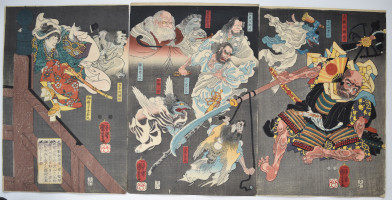
Click here to view image full size.
A triptych showing the famous battle on Gojo Bridge. The story relates how Benkei only needs one more blade to add to the 999 he has wrenched from samurai attempting to cross the bridge in order to fashion an invincible weapon. He meets Ushiwaka Maru (Minamoto no Yoshitsune’s childhood name) and challenges him to a fight on the bridge. Yoshitsune is aided by Sojobo, King of the Tengu (white-bearded in the centre) and other yamabushi tengu. Benkei loses the fight and becomes Yoshitsune’s loyal retainer. Published by Enshuya Hikobei, 1847-50. Robinson T194.
Fine impression, colour and condition. A lovely copy of this triptych. Signed Ichiyusai Kuniyoshi ga.
Status: Available
Toyohara KUNICHIKA (1835-1900)
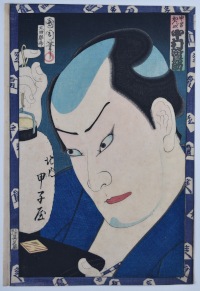
Click here to view image full size.
The actor Nakamura Shikan IV as Ishikawa Hachizaemon in the play Chuko musashi no abumi staged at the Nakamura-za Theatre in 4/1869. From a set of at least 22 prints published by Gusokuya Kahei, 1869. Kunichika was a hack artist who nevertheless produced some fine triptychs (horizontal and vertical) and this fine set of actor bust portaits.
Fine impression and colour. Minor edge soil, otherwise very good condition. Signed Kunichika hitsu.
Status: Available
Shunchosai HOKUSHU (Active 1822-32)
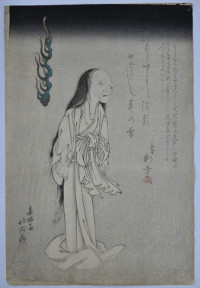
Click here to view image full size.
Onoe Kikugoro III as the ghost of Oiwa in Irohagana yotsuya kaidan, “Ghost Story of Yotsuya.” Performed at the Kado Theatre, 1/1826. Probably the best known Japanese ghost story and has been made into a number of films. Tamiya Iemon, a masterless samurai, murders the wife he has disfigured who comes back to haunt him until he is driven mad and subsequently killed by Oiwa’s brother. Evidently, Kikugoro’s performance was something of a sensation at the time as he gave a bravura performance playing both the ghost of Oiwa and Koheiji who were nailed on opposite sides of a panel dropped into the river. There are at least five states of this print. The first appears to be that illustrated in Roger Keyes, The Theatrical World Of Osaka Prints, Philadelphia Museum Of Art, 1973, no. 34, p. 108 with the engraver and two printers and the writing printed in silver. The example offered here appears to be a second state without the engraver and printers’ seal but with the writing still printed in silver. Other impressions with different seals and lacking the first three lines of writing and the silver are known. See The Tsubouchi Memorial Theatre Museum of Waseda University catalogue, Kamigata Prints in the former period: part 1, nos. 279 and 280. Also BM impression 1962,0210,0.2 which may be the last state.
Fine impression and colour with calligraphy in silver. Very good condition; full size. Signed Shunchosai Hokushu ga.
Status: Available
Katsushika HOKUSAI (1760-1849)
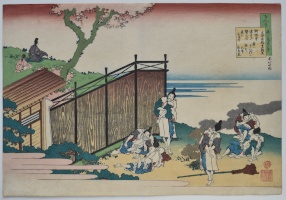
Click here to view image full size.
Hokusai’s interpretation of a poem by Onakatomi no Yoshinobu Ason (921-991). From an unfinished set: Hyakunin isshu uba ga etoki, “Pictures of One Hundred Poems by One Hundred Poets Explained by the Nurse.” The poems are from an anthology Hyakunin isshu, “One Hundred People, One Poem Each” compiled by the poet Fujiwara no Teika (1162-1241). The poet speaks of his love as being like the fire kept by the guards at the gate to the Imperial Palace: It burns hot only at night. There is actually some doubt that the poem can be attributed to Yoshinobu. Shows a group of off-duty Imperial carriage guards relaxing around the smoking embers of a fire. The poet with his servant is seen sitting on the distant hill. Published by Eijudo, 1835-36. A considerable number of original drawings exist for the set that were not turned into prints and are in various museums and private collections.
Fine impression, colour and condition. Signed Saki no Hokusai Manji.
Status: Available
Utagawa HIROSHIGE (1797-1858)
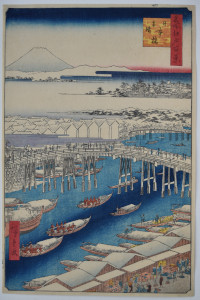
Click here to view image full size.
Nihonbashi yukibare, “The Nihon Bridge, Clear Weather After Snow.” From the set Meisho Edo hyakkei, “One Hundred Views of Edo.” The set published by Uoya Eikichi 1856-58 (this being 1856). The set comprises 118 prints by Hiroshige and another by Hiroshige II. However, three prints are dated 10/1858, the month following Hiroshige’s death and these are thought to be by Hiroshige II as well. They are: Ueno Yamashita, Ichigaya Hachiman and Bikunibashi. Number 1 from the set and a view of the Sumida River with Mt. Fuji in the distance. This is the starting point for the Tokaido Road.
Fine, early impression with gradation on the roofs and on Mt. Fuji. Fine colour. Margins trimmed a little, otherwise very good condition. Signed Hiroshige ga.
Status: Available
Utagawa HIROSHIGE (1797-1858)
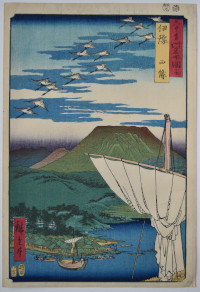
Click here to view image full size.
Iyo Province, Saijo. From a set of 69 prints [Dai Nihon] Rokujuyoshu meisho zue, “Famous Places in the Sixty-odd Provinces [of Japan]” published by Koshihei between 1853 and 1856, this being 1853. A large furled sail in the foreground with Saiju village on the water’s edge. Beyond is Mt. Ishizuchi.
Fine impression and colour. Light album backing, otherwise very good condition. Signed Hiroshige ga.
Status: Available
Ikeda EISEN (1790-1848)
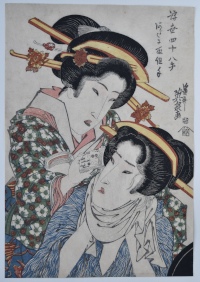
Click here to view image full size.
Two beauties in front of a mirror, Ada ni torikumite, “Grudge Match” from a set Ukiyo shiju hatte, “Forty-eight Habits of the Floating World.” This was a popular title for sets of prints – especially during the next thirty years. The sub-titles are quite obtuse, whereas in later series – for example Kuniyoshi’s set of c 1846 – the meanings are self-evident. A fine double okubi-e set published by Matsumura Tatsuemon, c 1821-22. Eisen was a prolific and repetitive artist but produced some fine landscapes and okubi-e sets. Rare.
Fine impression. Slight fading and minor soil, otherwise very good condition. Signed Keisai Eisen ga.
Status: Available
Kikugawa EIZAN (1787-1867)

Click here to view image full size.
An early complete 5-sheet (pentaptych) design being a mitate-e of a daimyo’s procession along Kugenuma beach with Enoshima island and Mt. Fuji in the background. Harugasumi hana iki retsu, “Journey in the Spring Mist.” The regional feudal lords (daimyo) were required every alternative year to travel to the capital of Edo. This was a deliberately costly affair and secured their loyalty as they had to leave their families in Edo. In this design young women replace the daimyo’s retinue. Published by Kawaguchiya Uhei, 1811-14. Its rare to find 5 or 6-sheet prints complete.
Fine impression and colour. Light album backing, otherwise very good condition. Signed Kikugawa Eizan hitsu.
Status: Available
Utagawa KUNIYOSHI (1797-1861)
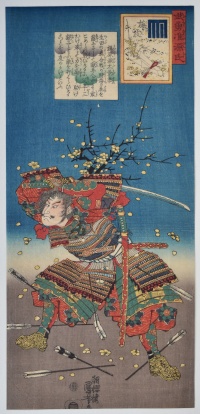
Click here to view image full size.
Chapter 32: Umegaye, “Plum brach” from an o-tanzaku set: Buyu nazorae Genji, “Heroic Comparisons for the Chapters of Genji.” Shows the Minamoto samurai Kajiwara Genda Kagesuye (1162-1200) fighting at Ikura-no-mori during the Genpai wars between the Taira and Minomoto clans. He has a plum branch stuck in his utsubo “quiver” in honour of his love Umegaye. The branch makes him an easy target for his enemies but he fights on regardless. Published by Ibaya Sensaburo, c 1843.
Very fine impression. Fine colour. Slightly trimmed at bottom, otherwise fine condition. Signed Cho-o-ro Kuniyoshi ga.
Status: Available
